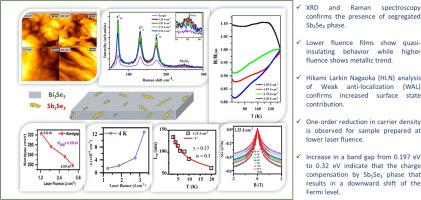Charge compensation by phase segregated Sb2Se3 phase in Bi1.95Sb0.05Se3 topological insulator thin films
IF 5.7
3区 材料科学
Q2 MATERIALS SCIENCE, MULTIDISCIPLINARY
引用次数: 0
Abstract
We report the charge compensation in Sb-doped Bi2Se3 thin films by the segregated Sb2Se3 phase. Films were deposited on Si/SiO₂ substrates via pulsed laser deposition at different laser fluences varying from 1.25 J-cm⁻² to 3.25 J-cm⁻². GI-XRD confirms the rhombohedral structure of Bi1.95Sb0.05Se3 along with a secondary Sb2Se3 phase. The phase fraction of the Sb2Se3 diminishes with increasing laser fluence. The film deposited at the lower fluence exhibits a bulk-insulating behavior, with a reduction in carrier density by one order. Magnetoconductivity analysis using the Hikami–Larkin–Nagaoka equation shows that α value decreases from 5 to 0.5, and the phase coherence exponent γ varies from 0.92 to 0.37 with decreasing fluence, indicating the suppression of bulk conduction channels. STM-IV studies reveal an increase in the band gap from 0.197 eV to 0.32 eV as the phase fraction of Sb2Se3 increases.

Bi1.95Sb0.05Se3拓扑绝缘体薄膜中相分离Sb2Se3相的电荷补偿
我们报道了Sb2Se3相在掺杂sb的Bi2Se3薄膜中的电荷补偿。通过脉冲激光沉积在Si/SiO₂基片上,激光强度从1.25 J-cm⁻²到3.25 J-cm⁻²不等。GI-XRD证实了Bi1.95Sb0.05Se3的菱形结构,并伴有Sb2Se3的次生相。随着激光辐照强度的增加,Sb2Se3的相分数逐渐减小。在较低通量下沉积的薄膜表现出块状绝缘行为,载流子密度降低了一个数量级。利用Hikami-Larkin-Nagaoka方程进行磁导分析表明,随着影响的减小,α值从5减小到0.5,相相干指数γ从0.92减小到0.37,表明体传导通道受到抑制。STM-IV研究表明,随着Sb2Se3相分数的增加,带隙从0.197 eV增加到0.32 eV。
本文章由计算机程序翻译,如有差异,请以英文原文为准。
求助全文
约1分钟内获得全文
求助全文
来源期刊

Materials Research Bulletin
工程技术-材料科学:综合
CiteScore
9.80
自引率
5.60%
发文量
372
审稿时长
42 days
期刊介绍:
Materials Research Bulletin is an international journal reporting high-impact research on processing-structure-property relationships in functional materials and nanomaterials with interesting electronic, magnetic, optical, thermal, mechanical or catalytic properties. Papers purely on thermodynamics or theoretical calculations (e.g., density functional theory) do not fall within the scope of the journal unless they also demonstrate a clear link to physical properties. Topics covered include functional materials (e.g., dielectrics, pyroelectrics, piezoelectrics, ferroelectrics, relaxors, thermoelectrics, etc.); electrochemistry and solid-state ionics (e.g., photovoltaics, batteries, sensors, and fuel cells); nanomaterials, graphene, and nanocomposites; luminescence and photocatalysis; crystal-structure and defect-structure analysis; novel electronics; non-crystalline solids; flexible electronics; protein-material interactions; and polymeric ion-exchange membranes.
 求助内容:
求助内容: 应助结果提醒方式:
应助结果提醒方式:


